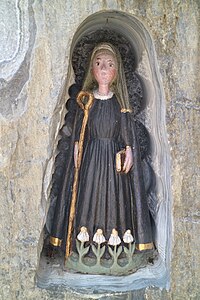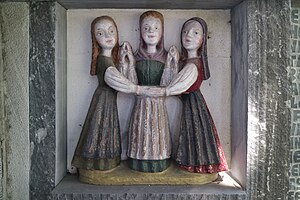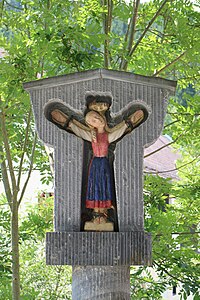Frauenbrunnen (Geistthal)

The Frauenbrunnen or Europabrunnen is a village fountain in the municipality of Geistthal-Södingberg in the Austrian state of Styria . The fountain, realized by the West Styrian sculptor Alfred Schlosser and opened in 2003, shows various motifs of female oppression and is dedicated to the memory of Martha Mosegger, who was executed as a witch in the 17th century .
Location
The women's fountain is located in the village of Geistthal , one of the two main towns in the Geistthal-Södingberg community, in northern western Styria . It is located in the center of the village on Landesstraße 315 (Stübinggrabenstraße) on the right above the Södingbach . With the parish church and the book house (Gasthof Kollmann) at the northern entrance to the town, two historical buildings are in the immediate vicinity. The fountain stands in the background of a small green area in the shade of a linden tree .
Emergence
In the run-up to its creation, the women's fountain caused a stir in Geistthal local politics. Mayor Manfred Feßl ( SPÖ ) traveled with a delegation to Hungary and Romania in January 1999 to establish business contacts and to receive the first marble blocks for the planned well construction. Additional blocks were to be procured from Italy , Spain , France and Portugal in cooperation with the Mayor of Voitsberg . In a leaflet Feßl informed the population about the building project with international participation, which was originally intended to be a “European traditional fountain” as a memorial to his deceased predecessor Adolf Bäuchler. The ÖVP local representation sharply criticized the plan and accused the local council of violating the law when deciding to build a well. The project was estimated to be cost-effective at 750,000 schillings , without first having it checked by the district authority and the state's nature conservation authority.
Because not every material was suitable for sculpting, Alfred Schlosser mainly used regional stones during the three years of work - the name Europabrunnen was retained. Another problem arose with the water supply to the well. The original idea of feeding the fountain from a container in the Södingbach, which runs directly below, was not implemented. A supply from the local water supply , i.e. with drinking water , is not compatible with water law . As a result of this standstill, rainwater regularly collects in the stone basins .
description
The entire fountain system extends in a slight curve over about 20 meters and consists of limestone and marble from Gradenberg and Salla . The most important feature are twelve colored glazed stoneware sculptures , which - starting with Hildegard von Bingen - show various historical and symbolic female figures. All figures wear the so-called " Gleinalm - Dirndl ", a local costume . Between the sculptures, which are housed in niches and indentations, there are selected texts that are intended to remind of the injustice experienced by women in Europe, especially during the time of the witch hunt. In addition to the ability to suffer, positive aspects such as the healing powers and spiritual strength of women are also discussed. The actual fountain consists of a central column with three gargoyles and five flat, hand-chiseled water basins, which are arranged on three levels and each connected by figurative gargoyles.
The facility can be roughly divided into four subject segments, which are described below from left to right (south to north). A summary or explanatory text can be found on the north side of the system facing away from the rest.
Closeness to nature
The first segment is dedicated to the role of women as a nature-loving being. A prominent example of this is the mystic and natural philosopher Hildegard von Bingen , venerated as a saint by the Roman Catholic Church . Characteristic features are her crook and the Bible as well as the flowers growing at her feet. The second sculpture shows three women with grain yolks , a butter barrel and a plate of fruit, with which the typical female activities of harvesting, preparing and distributing are shown.

|
He ran |

|
Believe that the door |

|
Witchcraft and martyrdom
The central motif of the complex is the witch trial against the 104-year-old Geistthaler farmer Martha Mosegger, who knows medicinal and herbs. She had to turn her back on the court during her trial and was sentenced to death on July 9, 1647 in Obervoitsberg by the ban judge Johann Andreas Barth. She was beheaded with the sword and her dead body was then cremated . Above the fountain column there is a depiction of the fictional popular saint, Kümmernis , of which a sculpture is in the book house , a former office building of Rein Abbey . The next sculpture shows Joan of Arc, also saint, at the stake.
War and oppression
The next three figures represent the role of women in conflicts and wars . The first two depict allegories of war - first a woman mediating a conflict between two sword-armed "fighters", then a woman shouldering a grenade , alluding to the fact that women traditionally bear the brunt of war (death relatives, devastation and starvation). The following sculpture symbolizes the humiliation of women through torture and rape .

|
The tortures |

|
Despite everything |

|
Redemption and peace
The last segment of the plant is devoted to more positive aspects. First you can see Lucia of Syracuse with the candle that is characteristic of her, as she tears the mask from a hypocrite's face. After all, a group of three dancing women stands for a hoped-for end to suffering and oppression.

|
The rays |

|
When God leads us |
Explanatory text
- ↑ The capital letter reliefs chiseled by Schlosser place no value on punctuation .
Web links
- Report in the magazine Neues Land
Individual evidence
- ↑ Andrea Grossmann: Contact wanted, but no gift packages. In: Kleine Zeitung , edition of February 4, 1999 (Weststeiermark edition), p. 25.
- ↑ Hans Breitegger: Flyer: Information should create trust. In: Kleine Zeitung , edition of March 14, 1999 (Weststeiermark edition), p. 27.
- ^ Andrea Grossmann: VP supervisory complaint against Mayor Feßl. In: Kleine Zeitung , edition of March 31, 1999 (Weststeiermark edition), p. 25.
- ↑ a b Karl Mayer: Brackish water in the "European fountain". In: Kleine Zeitung , August 13, 2004 edition (Weststeiermark edition), pp. 24-25.
- ^ A b Ernst Lasnik : 177 West Styrian Treasures. An art and culture guide through the Lipizzaner homeland. V. f. Collector, Graz 2014, ISBN 978-3-85365-273-2 , p. 52.
- ↑ a b c d e f Willi Senft: The new Geistthaler "Frauenbrunnen". In: Neues Land , edition of August 22, 2003, p. 12. Online PDF , accessed on September 26, 2019.
- ^ Siegfried Kramer: Minutes of the trial against Martha Mosegger. hexenprocess.at, accessed on September 26, 2019 . (Original text: Johann Andreas Barth, Bannrichter 1647)
Coordinates: 47 ° 10 ′ 14 " N , 15 ° 9 ′ 50.8" E



